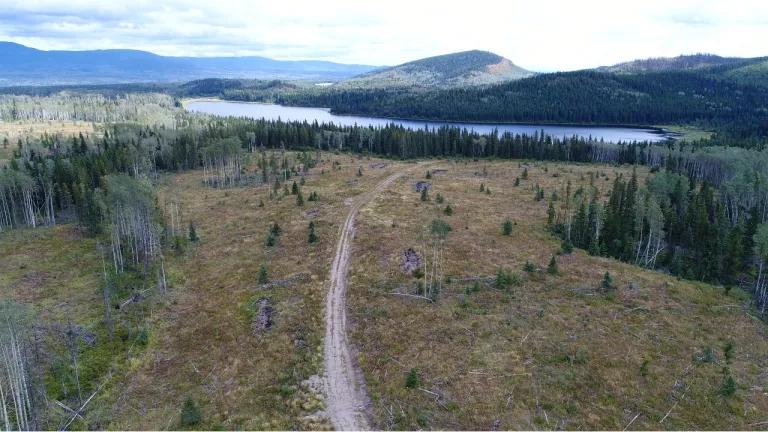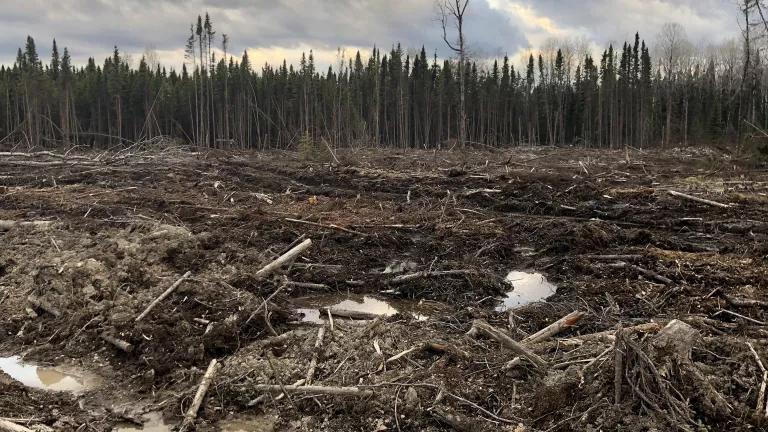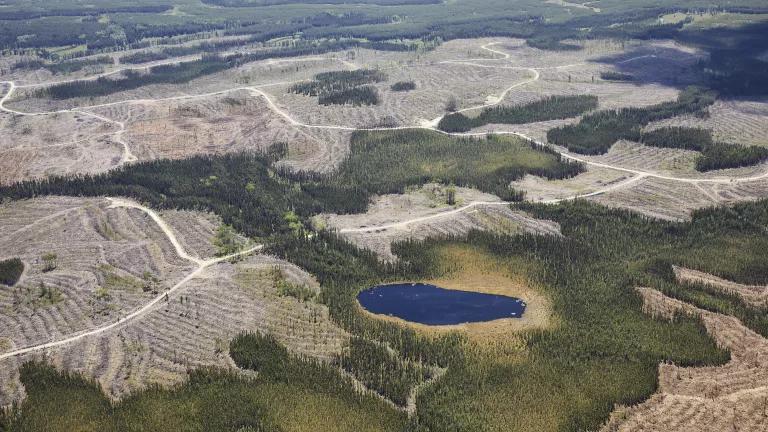Canada’s Climate Plan Has a Logging Industry-Sized Hole
Canada’s approach to industrial logging has been one of obfuscation and denial, pushing these emissions off the books.

Clearcut logging in Ontario
Each year, tens of megatonnes of carbon dioxide from Canada’s logging sector add to the atmospheric doomsday carbon clock, pushing the world closer to irreversible climate catastrophe. Yet in its new plan to deliver on its climate ambition, Canada has conveniently written out these emissions, leaving a forest-sized hole in its climate leadership and an entire industry insulated from the costs and exigencies of the climate crisis.
Canada’s Emissions Reduction Plan (ERP), released today, is Canada’s roadmap to cutting its 2005 greenhouse gas emissions by 40 to 45 percent by 2030. The plan provides detailed overviews of how it plans to achieve cuts across Canada’s major industrial sectors, from oil and gas to transportation. But not for its $3.5 billion logging industry and its carbon footprint of more than 80 Megatonnes (Mt) of carbon dioxide (CO2) each year–more than 10% of Canada’s other emissions, and equivalent to the emissions from Canada’s tar sands production. Canada’s approach to logging has instead been one of obfuscation and denial, pushing these emissions off the books. In the process, Canada has undermined the integrity of its climate leadership and built its natural climate solutions ambition on a warped, broken foundation of biased, artificial carbon accounting.
Climate change is not just about addressing emissions from smokestacks and tail pipes, but also from the degradation of the natural world. Each year, Canada’s logging industry clearcuts more than a million acres of boreal forest, the world’s most carbon-dense terrestrial ecosystem and a critical ally in the fight against climate change. Much of this logging occurs in never-before-logged primary forests, irreplaceable carbon storehouses that hold 30 to 50 percent more carbon than previously logged stands. Canada’s liquidation of its primary forests has earned it the rank of the third-highest intact forest landscape loss globally, behind only Russia and Brazil.
In converting never-before-logged primary forests into clearcuts, as a group of nearly 100 scientists highlighted in a letter to the government last week, the logging industry is breaking open a vast carbon vault and leaving a carbon debt that can last for centuries.
Yet, through a series of accounting artifices, loopholes, and flaws, Canada is essentially writing off the logging industry’s emissions, making a climate catastrophe appear to be carbon-neutral. As NRDC and our partners outlined in a recent report, in its annual greenhouse gas reporting to the United Nations Framework Convention on Climate Change (UNFCCC), Canada has made a series of policy choices around what forest emissions to exclude, what data to omit, and what targets to set that downplay the logging industry’s emissions by more than 80 Mt CO2 annually, decrease Canada’s overall climate ambition, and place Canada out of compliance with UNFCCC guidelines.
In failing to address this significant loophole, the ERP presents an incomplete picture of how Canada will actually achieve its emissions reduction goals, leaving 80 Mt of emissions entirely unaddressed and an industry free from any meaningful climate strategy.
The ERP has also failed to rectify Canada’s unique approach to calculating its 2030 target for the logging sector–an approach that, in effect, undermines the integrity of Canada’s overall emissions ambition. While, for every other sector, Canada evaluates its 2030 target based on 2005 net emissions, for logging Canada has adopted a “reference level approach.” This means, instead of calculating a target based on what carbon the atmosphere sees, Canada evaluates progress relative to a contrived metric based on what emissions would have been had the industry continued to operate under “business as usual” practices. This artificially inflates progress in the logging sector by 19 Mt CO2, and means that the 40 to 45 percent target Canada is trying to hit with its ERP comes with a large asterisk.
In failing to reckon with and address these flaws in its approach to the logging sector in the ERP, Canada has saddled itself with a half-baked climate plan that, ultimately, fails to live up to the country’s promises. It means that Canada is not, in fact, reaching the targets it claims, and that an entire sector will be left to self-regulate and evade accountability for its climate impact.
It also means that, while Canada has pledged in its ERP to make significant investments in natural climate solutions, any resulting policies will rest on a warped foundation. By writing off industrial logging’s climate cost, Canada is not just downplaying the industry’s impact, but also the benefits of protecting primary forests–which needs to be a top priority for any natural climate solutions framework. This sets up Canada to ignore the most critical policy approaches and gives credibility to false industry-touted solutions, such as biomass. If Canada is going to truly become a leader on natural climate solutions, it doesn’t just need a banker–it needs an accountant.
Canada has an opportunity to truly lead globally on the climate and on forest protections, while also creating the proper incentives to spur climate-friendlier logging practices and more sustainable economies. With the recent Glasgow Leaders’ Declaration on Forests and Land Use, which will determine whether the international community can truly adopt the forest protections needed to avoid catastrophic climate change, it’s more critical than ever that Canada adopt a robust plan for addressing its own forest emissions. The ERP is another addition to Canada’s house of cards on natural climate solutions. Canada urgently needs to remedy the foundations of its forest policy, before it all comes tumbling down.



